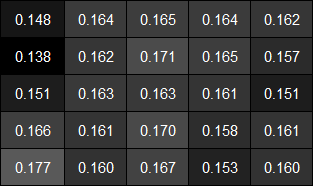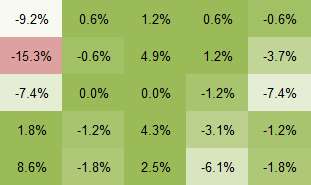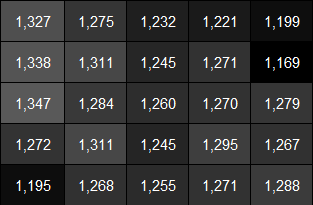LG 29EA93 Monitor Review - Rev. 1.25
by Chris Heinonen on February 12, 2013 8:49 PM ESTThe initial revision of the LG 29EA93 was very uniform overall, where I remarked, “For white uniformity, the 29EA93 is truly a cut above.” Despite this, LG was unhappy about the performance of the corners and went back and tightened the tolerances of assembling the screen to get better performance out of it. Unlike before, no areas drop below 180 cd/m² of light output, keeping the whole screen uniform within 10% when using the same 5x5 ANSI test pattern as before.
Light Output in cd/m2

Output Deviation Relative to Center

There are two points on the side that are slightly darker, in the same location as before, but the light loss in those areas is less than before. Overall the white uniformity manages to maintain its reputation of being great.
Black Uniformity is what had the issue before, with the corners having a lot more light creeping into the corners. This time that condition no longer exists. The only actual error that you can see is that one of the dimmer areas from the white uniformity is very dim in the black uniformity screen as well, but something being darker rather than lighter is a good thing.
Light Output in cd/m2

Output Deviation Relative to Center

Now looking at contrast uniformity, we see the most impressive result for the 29EA93 yet. The average contrast value here is 1267:1, and the corners maintain a contrast level of 1252:1. This is now the best display I’ve seen in terms of contrast uniformity, with no areas of the screen that are a cause of concern to me at all. I really hope other manufacturers see what LG was able to do here with better quality control and bring that to their displays to provide similar results.
Contrast Ratio

Contrast Ratio Deviation Relative to Center

For dE uniformity, I used the Uniformity tool available in CalMAN that can measure up to 45 points on the screen. For this display I used 21 points, in a 7x3 grid, which was a perfect match to the 21:9 ratio of the screen. The Uniformity tool isn’t completely finished yet, which is why I didn’t use it for brightness yet, but the dE uniformity is close to what we used to do, only with more data. Once the Uniformity tool is finished it’ll provide even better data, and I can go back to this review and update the graphs to match.
As you can see the center of the screen has very good color quality that we saw earlier. The extreme corners exhibit a bit of color drift with dE values that are a little worse, but only the upper-right corner moves past the 3.0 value that would indicate a color change that we can see. In comparison to the contrast numbers the color quality is only very good, but as this is the first display to be tested this way, it wouldn’t surprise me if this is the best display we see for a while and this method only accentuates the errors.
Colorchecker dE Uniformity
The LG 29EA93 was already a very good performer when it came to uniformity, and the improvements that LG made only increase that performance. The extra attention paid to make sure that the assembly of the extra-wide panel is done right has served to produce the most uniform consumer display that I’ve seen so far.











108 Comments
View All Comments
cheinonen - Thursday, February 14, 2013 - link
Since there seems to be a lot of feedback from those worried about the fact that LG provided a new sample that tested well, I decided to add some more comments about the matter, and clear some things up.- The first sample was also hand delivered by LG to me. Every monitor sample I have had has been from a PR company or a company directly, and none of them have been bought by myself.
- If it was so easy or even possible to hand-tune a sample to have the performance offered by Rev. 1.25 of the 29EA93, then wouldn't we expect every monitor that comes in for review to be that good? As it is, samples arrive that perform good and bad. You can look at the Acer monitor that was just reviewed to see it had issues (I had to manually loosen a screw to get the stand to work correctly, which they said would be fixed) and wasn't hand-tuned.
- You can also look at my Nixeus sample that had a brightness control issue, or many other display reviews that have been published. If it was so easy to game the system, every vendor would do it.
- Buying samples just isn't realistic. Most displays arrive for 30 days at most before going back to a company. Many arrive well before the street date so that reviews can be completed and published on the release date. This isn't possible if you need to purchase units, besides being cost prohibitive. Yes, some places would let me return them, but I have ethical issues about buying something I know I'll return, and then they will have to sell at a discount.
If I thought what LG was doing was in any way biasing my coverage, I wouldn't do it, but what they have done as far as providing samples is no different than any other company. What is different is their taking feedback and using it in a positive way, whereas many other vendors might try to deny the findings or just cut off communications, both of which have happened to me before. Being skeptical is fine, but I find no reason to think that LG wanted to anything else other than make a better product than they initially released, and providing the display to me is not different from the normal review process in any way at all.
5150Joker - Saturday, March 23, 2013 - link
Chris, LG should provide some of us a clear route to firmware upgrades that have purchased their displays. That I think is the chief concern among many of us that are concerned about buying an older version. If they were to release the updated firmware on their website in a reasonable time frame (say 1 month from now) with an easy path to upgrade, then nobody would be worried. As it is now, there is no way to differentiate between the older and newer model. This isn't limited to this model either, the LG 27EA83-D has the same problem. A korean website (www.playwares.com) was hand delivered a tuned unit and their lag tests were phenomenal. Unfortunately, I'm one of the people that already owns the 27EA83-D and would hate to be left out in the cold w/an early firmware. LG has a responsibility to clarify and rectify this situation for its customers.avihut - Thursday, February 14, 2013 - link
I was wondering which resolutions does the screen support?I mean does it only support the optimal 2560x1080 at this ratio or does it have something equivalent in the area of 1920x800 or even lower. My machine won't be able to do 2560x1080 on all my games, so I want to know if I'd be able to fall back on lower res but still get the same ratio.
Awesome review. Looks like a superb display.
cheinonen - Thursday, February 14, 2013 - link
With non-native resolutions you can have them scale to fit the screen, or do 1:1 pixel mapping for them.avihut - Friday, February 15, 2013 - link
But will the ratio preserve or will I have to play in letterbox mode?I wouldn't want to stretch 1920x1080 on this screen, since everything will look, well, stretched.
SpartanGR - Thursday, February 14, 2013 - link
How can we tell the diff between the old and the new one if i want to buy it?SpartanGR - Thursday, February 14, 2013 - link
Why can't we just firmware update our monitors? sigh....sheh - Thursday, February 14, 2013 - link
The start of the firmware-upgradable-monitor era? :) "Hey, I just overclocked my monitor using RadFirmware! Plus, scaler mode selection!"Why would TV-range chroma/luma affect contrast? It's supposed to be displayed expanded to the full range, no?
What quality differences are there in game mode?
Anyway, not the monitor for me. Waiting for some 3840x2400 24" 120Hz. OLED wouldn't hurt either, but that can wait another year or two.
cheinonen - Friday, February 15, 2013 - link
When calibrating for TV/Blu-ray/non-PC video, 16 is video black and 235 is video white, as opposed to 0 and 255 with PC content. The monitor shouldn't expand this, so you're calibrating to a smaller range. You can find some devices that will expand video content to the full RGB range (often labeled as RGB Full) that would then use the 0-255 range. For standard video content you only use a subset of that, so you'll have less dynamic range compared to PC.The PC mode was certainly bluish, with a higher color temperature, with fewer adjustments available in order to remove processing lag.
sheh - Saturday, February 16, 2013 - link
That's odd. I'd expect monitors in "TV mode" to expand 16-235/240 to 0-255, just like decent PC software players/decoders. Or maybe whatever feeds the video should do that. Or more like, either one, depending on the settings you select.Well, thanks.